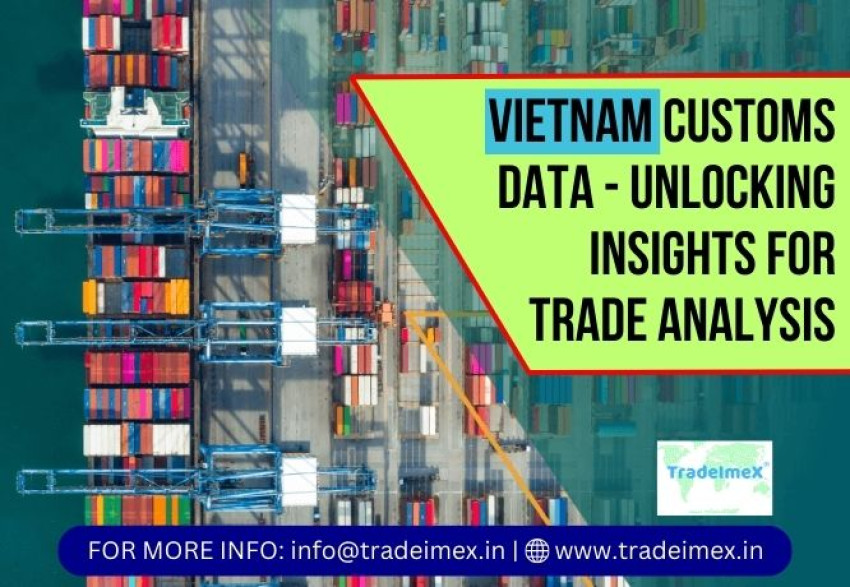
In today's interconnected global economy, trade analysis plays a crucial role in understanding market dynamics, identifying trends, and making informed business decisions. One valuable resource for such analysis is customs data, which provides a comprehensive view of a country's import and export activities. Today, we are going to share some insights and will explore the significance of Vietnam customs data and how it can unlock valuable insights for trade analysis.
THE IMPORTANCE OF VIETNAM CUSTOMS DATA
Vietnam, with its rapidly growing economy and increasing participation in international trade, has become a key player in the global marketplace. Analyzing Vietnam’s customs data provides a wealth of information to businesses, policymakers, and researchers alike. Here are some reasons why Vietnam customs data is highly valuable for trade analysis:
· TRACKING IMPORT AND EXPORT TRENDS
Vietnam customs data allows businesses to track import and export trends over time. By examining the volume, value, and types of goods being imported or exported, companies can identify emerging markets, potential trade partners, and lucrative business opportunities. It also helps monitor changes in demand for specific products, enabling businesses to adjust their strategies accordingly.
· MARKET INTELLIGENCE AND COMPETITIVE ANALYSIS
Access to Vietnam customs data provides market intelligence and facilitates competitive analysis. Businesses can gain insights into their competitors' import and export activities, identify their market share, and understand their pricing strategies. This information empowers companies to refine their offerings, optimize pricing, and develop effective marketing and sales strategies.
· CUSTOMS DATA HELPS TO DISCOVER VARIOUS TARIFF AND NON-TARIFF BARRIERS
Customs data helps uncover tariff and non-tariff barriers that may impact trade. By analyzing import and export data, businesses can identify the specific products subject to high tariffs, quotas, or other trade restrictions. This knowledge allows companies to navigate potential obstacles and explore alternative markets with more favorable trade conditions.
· ASSISTS IN OPTIMIZING THE SUPPLY CHAIN
For companies involved in global supply chains, Vietnam customs data offers valuable insights into the origin and destination of goods. By analyzing this data, businesses can identify key suppliers, track the movement of goods, and optimize their supply chain operations. This information aids in mitigating risks, reducing costs, and ensuring timely delivery of goods.
· CUSTOMS DATA HELPS IN GOVERNMENT POLICY ANALYSIS
Vietnam customs data provides policymakers with crucial information to evaluate the effectiveness of trade policies and make informed decisions. By examining trade flows, policymakers can identify sectors that require support, assess the impact of trade agreements, and develop strategies to foster economic growth.
HOW CAN WE ANALYZE VIETNAM CUSTOMS DATA?
To effectively analyze Vietnam customs data, various tools, and techniques can be employed. Some of the best ways to do this analysis are:
· DATA VISUALIZATION
Visualizing customs data through charts, graphs, and maps helps identify patterns, trends, and anomalies. Tools like Tableau, Power BI, or Python libraries such as Matplotlib and Seaborn can be used to create insightful visual representations of the data.
· STATISTICAL ANALYSIS
Statistical techniques such as regression analysis, time series analysis, and clustering can provide deeper insights into trade patterns, relationships between variables, and market segmentation. Programs like R or Python's pandas and NumPy libraries are commonly used for statistical analysis.
· MACHINE LEARNING
Machine learning algorithms can be leveraged to forecast trade volumes, detect anomalies, and uncover hidden patterns in customs data. Techniques such as classification, regression, and clustering can be applied to gain a deeper understanding of trade dynamics.
· DATA INTEGRATION
Combining customs data with other relevant datasets, such as economic indicators, demographic data, or industry-specific data, can provide a more comprehensive analysis. This integration allows for a holistic view of the trade landscape and facilitates more accurate predictions and insights.
CONCLUSION AND LAST VERDICT
Vietnam customs data holds immense potential for unlocking insights and driving trade analysis. By leveraging this data effectively, businesses can identify emerging opportunities, optimize supply chains, and make informed decisions. Policymakers can utilize this information to design effective trade policies and foster economic growth. As the global marketplace continues to evolve, the analysis of Vietnam customs data will remain a vital tool for understanding and capitalizing on trade dynamics.
Overall, the customs data of any country is a complete package when it comes to understanding the trade patterns, major trade partners, biggest traded goods, etc. Contact TradeImeX today to learn more about the same and buy for yourself if you are an enthusiastic trader.




